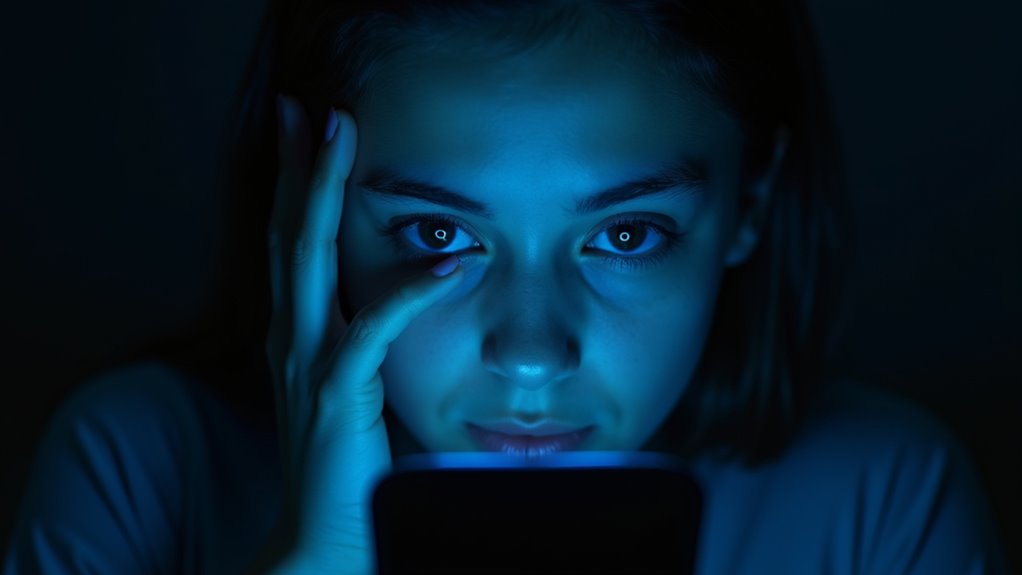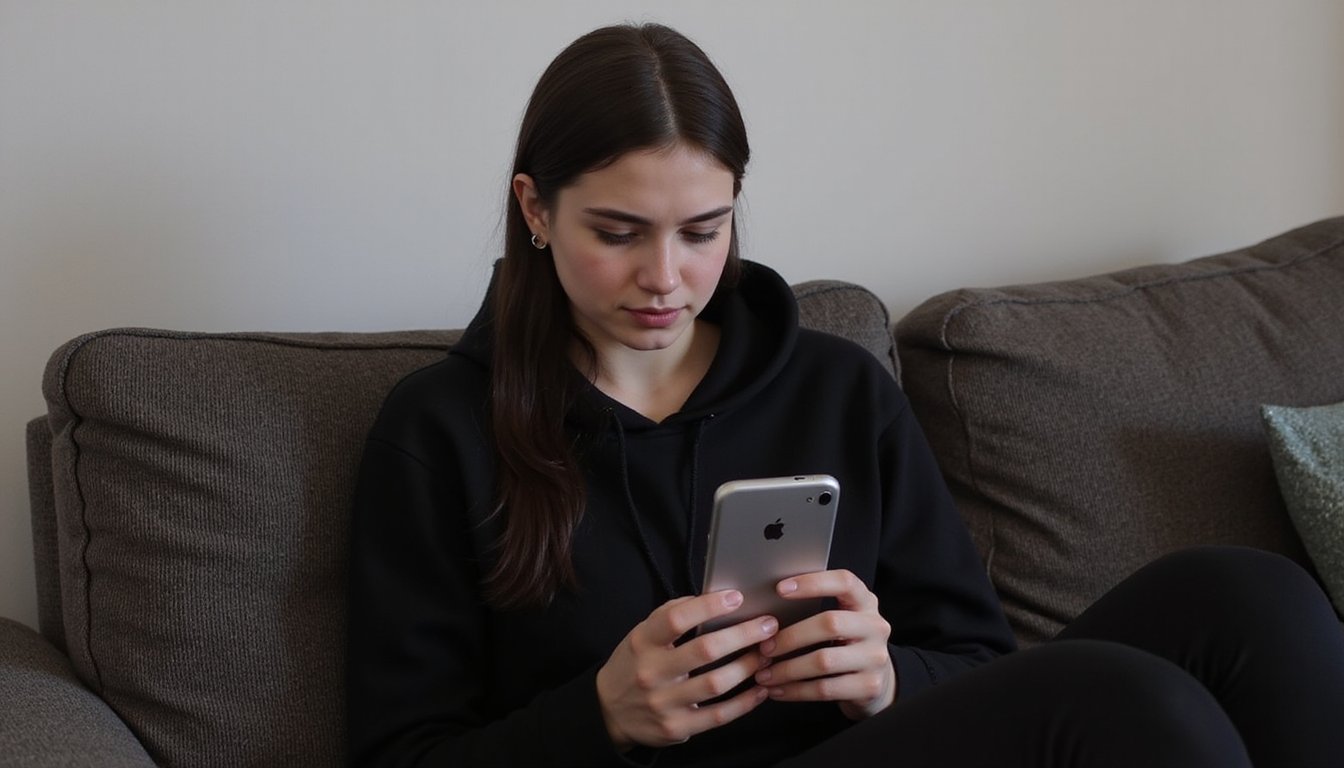Your smartphone addiction poses five significant health risks you can’t ignore. You’ll experience physical decline through reduced muscle mass and cardiovascular health, while disrupted sleep patterns cut your rest by up to 24 minutes per screen hour. Digital eye strain affects your vision, and “text neck” damages your posture. Most concerning, your brain undergoes addiction-like changes, affecting emotions and cognitive function. Understanding these dangers is your initial step in the direction of healthier technology use.
The Silent Impact on Physical Health and Fitness

While smartphones have revolutionized how we communicate and access information, their excessive use has emerged as a significant threat to physical health and fitness. Your phone addiction directly impacts your body’s composition, leading to decreased muscle mass, increased fat percentage, and serious metabolic consequences. You’ll notice decreased physical performance as prolonged sitting reduces cardiovascular health and stamina. Studies indicate that high-risk smartphone users take significantly fewer daily steps compared to moderate users. A recent scientific review revealed that smartphone addiction levels are directly linked to decreased sports performance. Modern society’s excessive smartphone dependence has become a critical health concern requiring immediate attention.
Research shows you’re likely experiencing musculoskeletal problems, particularly in your neck, shoulders, and upper limbs, from non-ergonomic phone use. Even 15-30 minutes of continuous use can trigger pain symptoms. Your vision suffers too, with increased risk of eye strain and digital fatigue. Most concerning is how phone addiction reduces your daily physical activity, replacing active pursuits with sedentary behavior and potentially contributing to obesity and cardiovascular disease risks.
Sleep Quality: A Hidden Casualty of Screen Time
Although smartphones provide unprecedented convenience, their use before bedtime wreaks havoc on your sleep quality through multiple mechanisms. Each hour of screen time in bed slashes your sleep duration by 24 minutes and increases your insomnia risk by 59%. You’ll experience considerably delayed bedtimes, with daily users falling asleep 21 minutes later on weekdays and 40 minutes later on weekends.
The consequences extend beyond mere sleep duration. Poor sleep quality from evening screen exposure leads to attention deficit issues and depressive symptoms. Research shows young university students are particularly vulnerable to these effects. A concerning 65.7 percent of students exhibit poor sleep quality scores, highlighting the widespread nature of this problem. This is especially concerning since violent content before bed significantly disrupts sleep patterns. If you’re using screens 1-2 hours before bed, you’re disrupting your natural melatonin production essential for healthy sleep onset. The impact is particularly severe for evening chronotypes and those engaging with social media in bed, resulting in increased daytime fatigue and reduced sleep efficiency.
Your Eyes Under Digital Strain

Digital eye strain now affects over half of all device users, creating a widespread health concern that extends beyond mere discomfort. When you’re using digital devices, your blink rate decreases notably, leading to worsening dry eye and irritation. You’re likely experiencing this if you spend more than five hours daily on screens, as 60% of Americans do. Even thirty minutes of use can trigger eye strain symptoms, particularly in children. The pandemic has significantly worsened this issue, with digital learning norms causing unprecedented increases in screen time. Women tend to experience more severe symptoms, with higher strain rates reported among female users.
Digital eye strain has become a modern epidemic, transforming screen time from a convenience into a growing health challenge for millions.
Common symptoms you might experience include:
- Blurred vision and difficulty refocusing after screen use
- Burning sensations and persistent eye fatigue
- Increased sensitivity to light and glare
While eye strain solutions like the 20-20-20 rule can help, you’ll need a thorough approach. Professional eye care consultations, proper lighting, and screen modifications are essential for long-term relief. If you’re using multiple devices simultaneously, you’re at even higher risk, as this compounds the strain on your visual system.
The Rising Toll on Neck and Body Posture
As smartphone addiction continues to rise, alarming statistics reveal severe impacts on users’ neck and spinal health. With nearly half of university students reporting neck disorders and over 62% exhibiting “text neck” posture, you’re likely developing harmful muscular tension patterns without realizing it. Studies show a staggering 63.3% of teens demonstrate smartphone addiction behaviors. The COVID-19 pandemic has dramatically increased these risks, with web-based learning tools forcing students to spend more time on devices. Recent studies show that individuals who spend over 4 hours daily on their phones experience significantly higher neck pain and reduced muscle endurance.
Your head’s natural 10-pound weight multiplies dramatically when you flex your neck to view your screen, creating abnormal stress on your cervical spine. These sustained postures lead to postural compensation strategies that compromise your neck’s muscle efficiency and stability. Research shows a direct correlation between smartphone addiction levels and neck disability (r = 0.524), while increased screen time worsens your neck muscle endurance. To protect yourself, maintain your phone at eye level and use proper holders to minimize neck flexion.
Brain Changes and Emotional Well-being at Risk

Beyond the physical toll on your posture, smartphone addiction triggers profound changes in your brain’s structure and function. Your excessive screen time creates digital dopamine dependency, altering essential neurotransmitters that regulate mood and emotions. These changes can lead to severe social isolation effects, anxiety, and depression while disrupting your brain’s reward system. A recent study showed that after 72 hours of restriction, smartphone users exhibited significant withdrawal-like brain activity patterns. Recent electroencephalography data reveals resting-state brain activity is significantly altered in phone-addicted individuals. Young users are particularly vulnerable to developing brain rot symptoms from excessive digital media consumption.
Excessive smartphone use rewires your brain’s chemistry, creating a destructive cycle of dopamine dependence and emotional instability.
- Your brain experiences addiction-like withdrawal symptoms when you limit phone use, similar to substance addiction patterns
- Excessive usage impairs your executive functions, affecting decision-making abilities and working memory
- Your emotional processing becomes compromised, leading to desensitization and negative self-concept
Research shows these neurobiological changes mirror other behavioral addictions, affecting regions like your prefrontal cortex and ventral striatum. The cognitive impact manifests through reduced attention span, memory decline, and diminished problem-solving capabilities, creating a concerning cycle of digital dependency.
Frequently Asked Questions
How Long Does It Take to Break a Smartphone Addiction?
Based on research, you’ll typically need 6 months to break a smartphone addiction, though your recovery timeline depends on your initial addiction severity. You’ll improve your chances of success by maintaining a regular digital detox schedule and developing awareness of phone usage patterns. Your recovery odds increase if you have better baseline quality of life and goal stability. Only about 29% of people complete the full recovery period.
Can Blue Light Blocking Glasses Prevent All Smartphone-Related Vision Problems?
No, blue light-blocking glasses can’t prevent all smartphone-related vision problems. While they may help with blue light exposure effects, they don’t address key issues like reduced blinking and poor screen viewing habits. For thorough digital eye strain prevention, you’ll need to combine multiple strategies: taking regular breaks using the 20-20-20 rule, maintaining proper viewing distance, using artificial tears, and ensuring you have the correct vision prescription.
Are Children More Susceptible to Smartphone Addiction Than Adults?
Yes, children are extremely more susceptible to smartphone addiction than adults. You’ll find that individuals under 25 are nearly three times more likely to develop addictive behaviors with smartphones compared to older adults. During the pandemic, over 53% of school children showed addiction symptoms, with primary school students being most affected. This highlights why increased parental supervision and early intervention strategies are essential in protecting young people from developing unhealthy smartphone dependencies.
What’s the Safest Minimum Distance to Hold Your Phone While Using?
You should maintain a minimum safe holding distance of 10-12 inches (25-30 cm) from your phone to considerably reduce RF radiation exposure. For ergonomic hand positioning, keep your device at eye level and arms-length while viewing. When carrying your phone, maintain at least 1-2 cm separation from your body. If you’re using it for extended periods, consider hands-free options like speakerphone or headphones to optimize safety and comfort.
Do Specific Apps or Activities Contribute More to Smartphone Addiction?
Yes, social media usage and communication apps are the leading drivers of smartphone addiction. You’re most vulnerable to developing compulsive behaviors through platforms that provide instant social gratification and continuous engagement loops. Gaming addiction also plays a significant role, especially when you’re using games to cope with stress or loneliness. These apps are deliberately designed with variable reward systems that keep you checking and scrolling throughout the day.






